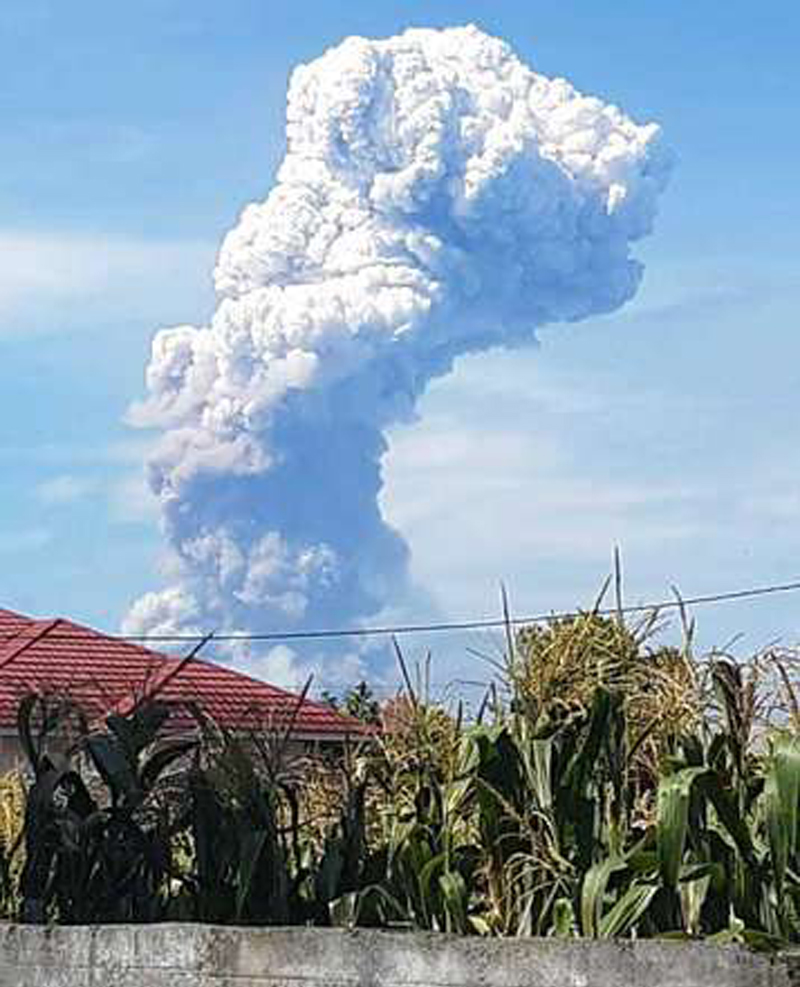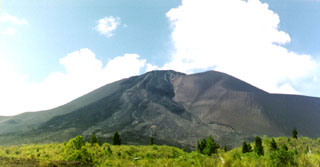Report on Soputan (Indonesia) — January 2019
Bulletin of the Global Volcanism Network, vol. 44, no. 1 (January 2019)
Managing Editor: Edward Venzke.
Soputan (Indonesia) Ash explosions on 3-4 October and 16 December 2018
Please cite this report as:
Global Volcanism Program, 2019. Report on Soputan (Indonesia) (Venzke, E., ed.). Bulletin of the Global Volcanism Network, 44:1. Smithsonian Institution. https://doi.org/10.5479/si.GVP.BGVN201901-266030
Soputan
Indonesia
1.112°N, 124.737°E; summit elev. 1785 m
All times are local (unless otherwise noted)
Soputan typically erupts every few years with ash explosions, lava flows, and Strombolian eruptions (SEAN 07:08, BGVN 42:03). After a short eruptive period during January-February 2016, the volcano quieted, with only occasional steam plumes and low seismicity. An ash explosion on 3 October 2018 marked the beginning of a new eruption. The volcano is monitored by the Pusat Vulkanologi dan Mitigasi Bencana Geologi (PVMBG). This report discusses activity during September through December 2018.
According to PVMBG, increased seismicity at Soputan was notable on 2 October 2018, characterized by an increased number of signals indicating emissions and avalanches (which began in September and mid-July, respectively), increased Real-time Seismic-Amplitude Measurement (RSAM) values, and a higher number of volcanic earthquakes (since September). Data from a thermal camera showed increased summit temperatures, interpreted as indicating the presence of lava. The Alert Level was increased to 3 (on a scale of 1-4) on 3 October; people were advised not to approach the craters within a radius of 4 km, with an additional expansion to 6.5 km on the WSW flank due to increased risk from a breach in the crater rim.
An eruption at 0847 on 3 October produced a dense ash plume that rose 4 km above the summit and drifted W and NW (figure 16). Based on seismic data the event lasted six minutes. Events at 1044, 1112, and 1152 produced ash plumes that rose 2, 2.5, and 5 km above the crater rim, respectively. A thermal anomaly identified in satellite data significantly increased, and incandescent ejecta at the summit was clearly observed by residents. Avalanches of material traveled 2.5 km down the NE flank.
 |
Figure 16. An ash plume from Soputan on 3 October 2018, as seen from Tomohon (25 km NNE). Courtesy of AP Photo/Hetty Andih. |
Based on satellite images, information from PVMBG, and wind model data, the Darwin Volcanic Ash Advisory Center (VAAC) reported that on 4 October ash plumes rose to an altitude of 4.6 km and drifted W. On 16 October, PVMBG issued a Volcano Observatory Notice for Aviation (VONA) that noted only white emissions; consequently, the Aviation Color Code was lowered to Yellow.
According to PVMBG, seismic activity rapidly and significantly increased at 1700 on 15 December. An eruption began at 0102 on 16 December, though dark and foggy conditions prevented views of emissions. The event lasted for almost 10 minutes, and thunderous sounds were heard at the Soputan Volcano Observation Post located in Silian Raya (about 10 km SW). The conditions improved about two hours later, and a dense ash plume was visible, rising 3 km above the summit and drifting SE. Incandescence from the summit was also visible. An event that began at 0540 produced dense gray-to-black ash plumes that rose as high as 7 km above the summit (summit elevation is 1,785 m) and drifted SE. The event lasted for 6 minutes and 10 seconds based on the seismic network. Ash plumes from events at 0743 and 0857 rose as high as 7.5 km and drifted SW.
Satellite data. Thermal anomalies, based on MODIS satellite instruments analyzed using the MODVOLC algorithm, were observed during two days in September (14 and 30 September), seven days in October, and lastly on 8 November 2018. Pixel numbers peaked during 3-7 October (six pixels on 3 October). The MIROVA (Middle InfraRed Observation of Volcanic Activity) volcano hotspot detection system, also based on analysis of MODIS data, detected numerous hotspots within 5 km of the volcano during the reporting period. Significant sulfur dioxide levels near the volcano were recorded by NASA's satellite-borne ozone instruments on or just after the 3 October and 16 December explosions.
Geological Summary. The Soputan stratovolcano on the southern rim of the Quaternary Tondano caldera on the northern arm of Sulawesi Island is one of Sulawesi's most active volcanoes. The youthful, largely unvegetated volcano is the only active cone in the Sempu-Soputan volcanic complex, which includes the Soputan caldera, Rindengan, and Manimporok (3.5 km ESE). Kawah Masem maar was formed in the W part of the caldera and contains a crater lake; sulfur has been extracted from fumarolic areas in the maar since 1938. Recent eruptions have originated at both the summit crater and Aeseput, a prominent NE-flank vent that formed in 1906 and was the source of intermittent major lava flows until 1924.
Information Contacts: Pusat Vulkanologi dan Mitigasi Bencana Geologi (PVMBG, also known as Indonesian Center for Volcanology and Geological Hazard Mitigation, CVGHM), Jalan Diponegoro 57, Bandung 40122, Indonesia (URL: http://www.vsi.esdm.go.id/); Badan Nasional Penanggulangan Bencana (BNPB), National Disaster Management Agency, Graha BNPB - Jl. Scout Kav.38, East Jakarta 13120, Indonesia (URL: http://www.bnpb.go.id/); Darwin Volcanic Ash Advisory Centre (VAAC), Bureau of Meteorology, Northern Territory Regional Office, PO Box 40050, Casuarina, NT 0811, Australia (URL: http://www.bom.gov.au/info/vaac/); Hawai'i Institute of Geophysics and Planetology (HIGP) - MODVOLC Thermal Alerts System, School of Ocean and Earth Science and Technology (SOEST), Univ. of Hawai'i, 2525 Correa Road, Honolulu, HI 96822, USA (URL: http://modis.higp.hawaii.edu/); MIROVA (Middle InfraRed Observation of Volcanic Activity), a collaborative project between the Universities of Turin and Florence (Italy) supported by the Centre for Volcanic Risk of the Italian Civil Protection Department (URL: http://www.mirovaweb.it/); Global Sulfur Dioxide Monitoring Page, Atmospheric Chemistry and Dynamics Laboratory, NASA Goddard Space Flight Center (NASA/GSFC), 8800 Greenbelt Road, Goddard, Maryland, USA (URL: https://so2.gsfc.nasa.gov/); Associated Press (URL: http://www.ap.org/).

